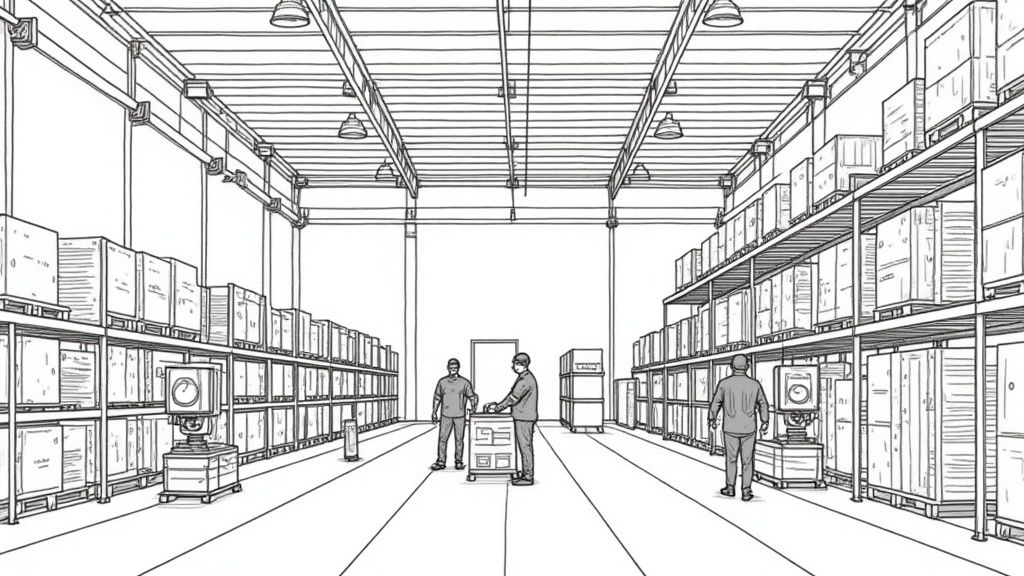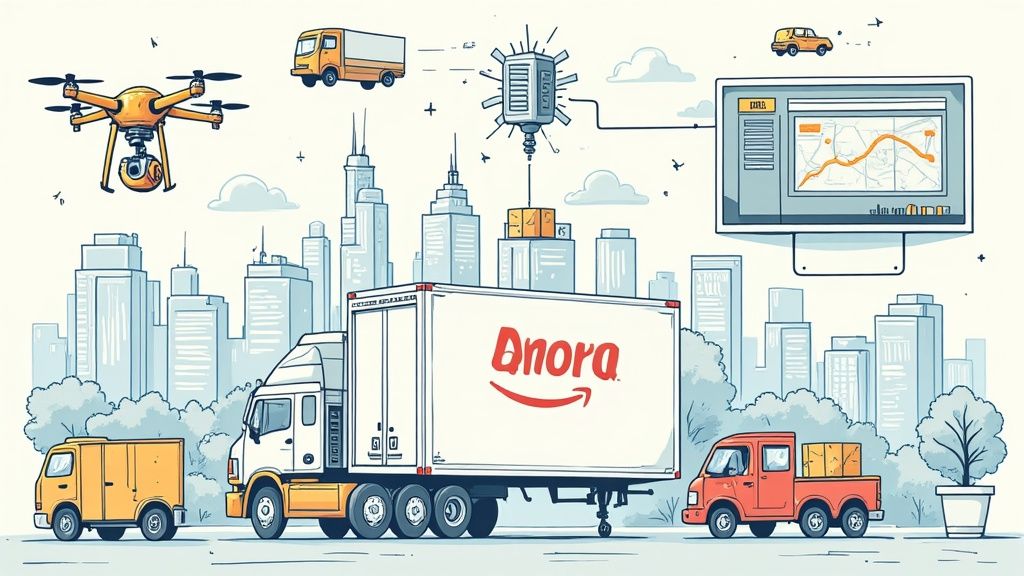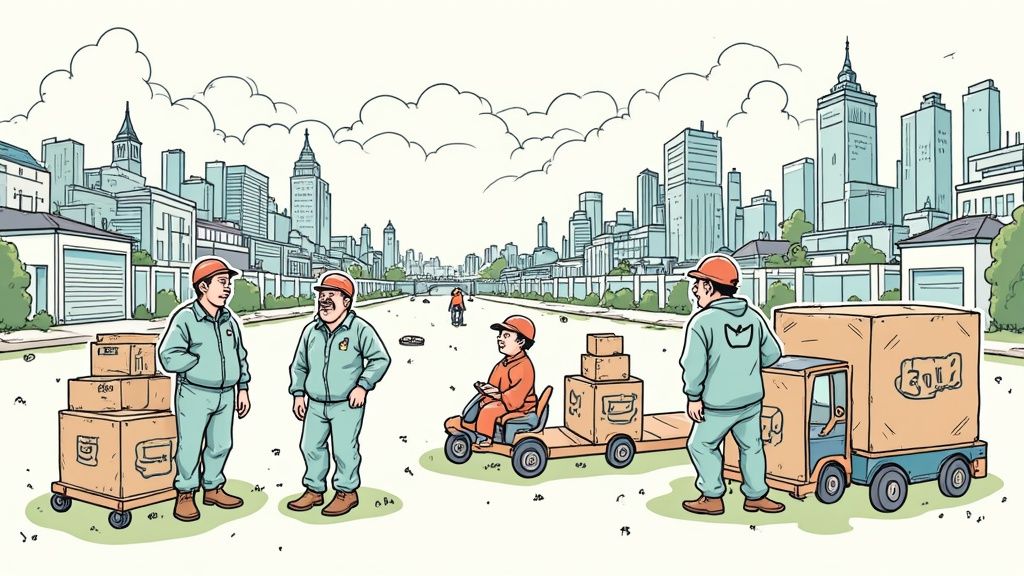Building the World’s Most Advanced Distribution Network
From a single Seattle warehouse to a global powerhouse, Amazon’s supply chain evolution shows what’s possible when logistics meet ingenuity. The company’s smart approach to facility placement has not only changed delivery speeds but reset what customers expect from online shopping.
Strategic Facility Placement: The Cornerstone of Amazon Supply Chain Management
Think of Amazon’s distribution network as a massive web, with millions of square feet of warehouses positioned closer and closer to population centers. This isn’t random – it’s a calculated strategy to enable faster shipping while keeping transportation costs down. Just as a local library makes it easy to get books quickly, Amazon’s nearby facilities mean faster deliveries for customers.
Specialized Facilities: Handling Every Link in the Chain
The network includes different types of facilities, each with a specific job in the supply chain. Some handle bulk shipments from manufacturers, while others focus on sorting individual orders or processing returns. This setup helps Amazon move huge product volumes accurately and quickly. For example, dedicated return centers make the process smooth for customers while helping Amazon quickly get returned items back into stock.
The Hub-and-Spoke Model: The Engine of Efficient Distribution
Amazon uses a hub-and-spoke system, similar to how airlines connect flights through major airports. Large fulfillment centers serve as hubs, receiving big shipments and sending items to smaller facilities closer to customers. This approach beats traditional linear distribution by being more flexible and efficient at moving products where they need to go.
Data-Driven Decisions: Achieving Unprecedented Efficiency
By tracking millions of daily shipments and analyzing the results, Amazon constantly fine-tunes its distribution strategy. The company studies performance data to spot slowdowns and opportunities to improve. This helps maintain high accuracy while processing orders faster than competitors. The focus on steady improvement through data keeps Amazon setting new standards in supply chain excellence.
How AI Powers Amazon’s Predictive Supply Chain Operations
AI technology is central to how Amazon makes decisions in its supply chain operations. Rather than just monitoring shipments and reviewing past data, Amazon uses AI to actively predict and fine-tune operations across its massive global network. This capability is essential for managing billions of product deliveries, especially during major sales events like Prime Day.
Using Machine Learning to Predict Customer Demand
Amazon’s machine learning systems analyze mountains of data to forecast what customers will order. The algorithms look at sales history, shopping patterns, weather forecasts, economic data and more to predict demand with high accuracy. For example, during the 2023 Cyber Monday event, Amazon’s AI predicted and prepared for over 400 million product orders in a single day. This foresight allows Amazon to stock the right items in the right quantities ahead of time.
Smart Inventory Placement to Lower Costs
Getting inventory to the right locations is like a complex chess game, and AI helps Amazon make the smartest moves. The systems analyze regional demand patterns to determine where products should be stored across Amazon’s fulfillment centers. Placing items closer to where customers are likely to order them means faster deliveries and lower shipping costs. In 2020, this AI-guided approach saved Amazon $1.6 billion in transportation expenses while reducing CO2 emissions by 1 million tons.
AI and Robots Working Together in Warehouses
Inside Amazon’s warehouses, AI directs robotic systems to move products efficiently. The AI orchestrates the robots’ movements to retrieve and transport items quickly and accurately. This combination has cut processing times by 25% while improving precision. The technology also enhances safety by optimizing how tasks are assigned. For instance, delivery stations that normally handle 60,000 packages per day can process over 110,000 during peak periods thanks to this AI-robot teamwork.
Always Learning and Improving
Amazon takes a proactive approach to refining its supply chain through data analysis. The company’s AI systems constantly study performance metrics to spot potential issues before they become problems. This ongoing analysis and optimization, powered by machine learning and real-time data, helps Amazon stay ahead of supply chain challenges. As a result, Amazon can consistently meet current customer needs while preparing for future growth in demand.
Advanced Robotics in Modern Warehouse Operations

AI guides Amazon’s supply chain strategy, but it’s their sophisticated robotics that powers the day-to-day operations inside their fulfillment centers. These aren’t basic transport robots – they’re intricate systems working together to optimize every step of the warehouse process. The combination of robotics and smart supply chain management has helped Amazon set new standards for logistics efficiency.
Sequoia: Smart Storage Solutions in Action
A prime example of Amazon’s robotic innovations is its Sequoia system. Picture a massive, automated library where robotic arms quickly pinpoint and retrieve exactly what’s needed. That’s how Sequoia works – it’s a storage solution that helps Amazon place items 75% faster than traditional methods. This speed boost is critical for managing the constant flow of products while maintaining the quick delivery times that customers expect.
Inventory Performance Index: Data-Driven Decisions
The robotics system works hand-in-hand with the Inventory Performance Index (IPI) to make smarter storage decisions. Think of IPI as a real-time dashboard showing what’s selling well and what’s not, helping optimize product placement across millions of square feet of warehouse space. This ensures popular items are easy to access while less-demanded products don’t take up prime real estate, making the whole supply chain more efficient.
Making Warehouses Safer Through Automation
Beyond just speed and efficiency, robotics has made Amazon’s warehouses safer for workers. By handling heavy lifting and repetitive movements, robots have reduced employee injuries by 15%. This lets workers focus on tasks that need human judgment and careful handling. It’s a practical example of how automation can improve both productivity and workplace safety. The combination of faster processing, better accuracy, and reduced injury risk shows how robotics is changing warehouse operations for the better.
Empowering Independent Sellers with Enterprise-Level Logistics

The robust infrastructure behind Amazon’s success is now accessible to independent sellers. The company has opened up its supply chain tools and services to third-party businesses, putting small and medium sellers on equal footing with larger corporations. This gives independent merchants access to the same high-quality logistics capabilities that were once limited to major enterprises, fundamentally changing how smaller companies operate in the online marketplace.
Fulfillment by Amazon (FBA): The Game-Changer for Small Businesses
Fulfillment by Amazon (FBA) is the key service making this possible. Through FBA, sellers can store products in Amazon’s warehouses and use the company’s distribution network. Amazon handles everything – picking, packing, shipping, and customer service – freeing up sellers to focus on growing their business. For instance, a small artisan making handcrafted jewelry can now reach customers worldwide without managing their warehouse or figuring out international shipping.
Boosting Sales Conversion Through Faster Delivery
Using FBA gives sellers a major advantage in converting browsers to buyers. Access to Prime shipping lets sellers tap into Amazon’s massive base of Prime members who prioritize quick, free delivery. The numbers speak for themselves – sellers typically see a 20% jump in sales just by offering faster shipping through Amazon’s network. This directly improves their bottom line and helps them compete more effectively.
Cost Savings and Operational Efficiency
While some might expect premium logistics to be costly, FBA often reduces expenses for independent sellers. Amazon’s size allows it to negotiate better shipping rates, passing those savings to sellers. Plus, businesses can cut warehouse and staff costs by letting Amazon handle fulfillment. This frees up money for other priorities like marketing or product development. The combination of lower shipping costs, reduced warehousing needs, and simpler operations helps boost profit margins.
Data-Driven Inventory Management: Optimizing for Success
Beyond shipping and storage, Amazon provides sellers with advanced tools to manage inventory. Real-time data shows stock levels, sales patterns, and demand forecasts. This helps sellers make smart choices about inventory levels, warehouse placement, and restocking timing. They can keep just enough stock to meet demand while minimizing storage fees, especially during busy seasons. Having enterprise-grade data tools means small sellers can now manage inventory as efficiently as major retailers, helping them thrive in the Amazon marketplace.
Mastering Global Supply Chain Complexity
As companies grow domestically, expanding into international markets becomes the next major frontier. Amazon’s supply chain extends far beyond U.S. borders, orchestrating millions of cross-border shipments with exceptional precision. This global reach relies on three key pillars: international fulfillment centers placed in strategic locations, optimized transportation routes across countries, and sophisticated customs management. Together, these elements create a seamless flow of goods worldwide.
Navigating International Logistics: A Complex Web
Consider the journey of a product from a factory in China to a customer’s doorstep in Europe. At each step – from manufacturing through export, import, customs clearance, and final delivery – unique challenges emerge. Different regulations apply in each country, language barriers need bridging, and logistical hurdles must be overcome. Amazon addresses these complexities through deep partnerships with international carriers, customs brokers, and government agencies, ensuring smooth product movement across borders.
Fulfillment Centers Around the Globe: Strategically Placed for Efficiency
Much like its domestic network, Amazon’s global presence centers on well-positioned fulfillment facilities worldwide. These international hubs store inventory closer to customers in different regions, cutting both shipping times and costs. For example, when Japanese customers order products, items can ship from nearby Asian fulfillment centers rather than crossing the Pacific from America, dramatically reducing delivery windows.
Customs and Regulatory Compliance: Ensuring Smooth Cross-Border Flow
Managing complex customs regulations presents one of international trade’s biggest hurdles. Amazon has built robust systems to handle documentation requirements, import/export rules, and tax obligations across countries. This expertise allows sellers to concentrate on their products while Amazon manages the intricate details of international trade compliance. By handling these regulatory complexities efficiently, Amazon keeps goods flowing smoothly between nations with minimal delays.
Cost Savings and Reliability in International Commerce
The smart management of global logistics creates major cost benefits for Amazon and its sellers. Amazon provides competitive international shipping rates by finding the most efficient transportation routes and streamlining customs processes. This makes global market entry more affordable for sellers. Just as importantly, the dependability of Amazon’s international network ensures products reach customers on schedule and in perfect condition, building trust worldwide. This blend of affordability and consistency drives Amazon’s continued global growth.
Shaping the Future of Supply Chain Innovation

Amazon continues to push boundaries in supply chain management through ongoing developments in automation, delivery systems, and sustainability. These advances are reshaping how products move from manufacturers to consumers, with Amazon’s drive for efficiency setting new standards across the industry.
The Rise of Autonomous Delivery
The future of delivery is already taking shape through drones and self-driving vehicles that bring packages right to your door. Amazon has made significant investments in this technology to speed up deliveries while reducing costs, particularly in areas with limited infrastructure. For instance, drones can bypass traffic jams and reach remote locations faster than traditional delivery methods, giving customers faster access to their orders.
Personalized Delivery Experiences
Amazon is developing ways to give customers more control over their deliveries through flexible options. You’ll be able to pick specific delivery times, change delivery locations while packages are in transit, and even combine multiple orders into single deliveries to reduce environmental impact. These choices make the delivery process more convenient while improving customer satisfaction.
Sustainable Supply Chains: A Core Focus
Making supply chains environmentally responsible is central to Amazon’s plans. The company is taking real steps to reduce its environmental impact through several key initiatives. These include switching to renewable energy in warehouses, planning smarter delivery routes to use less fuel, and testing eco-friendly packaging options. The company’s goal to reach net-zero carbon emissions by 2040 shows its serious commitment to sustainability.
The Power of Predictive Analytics
Building on current AI capabilities in demand forecasting and inventory management, Amazon is expanding its use of predictive analytics. Advanced systems will process real-time data from weather patterns, social trends, and economic indicators to spot potential disruptions before they happen. This helps Amazon adapt quickly to changes while better understanding what customers want, leading to more accurate inventory planning and product recommendations.
Looking to optimize your Amazon presence and improve your supply chain performance? eStore Factory, a leading eCommerce agency with over 10 years of experience, provides complete services for Amazon sellers. Our team of experts can help boost your sales, increase brand visibility, and handle the complexities of selling on Amazon.
